Dear Perumale,
‘Koil Azhwar’. I had heard this term when much younger, and had not given too much of a thought to it. Then one day when adiyen started realising about the divinity of the 12 Sri Vaishnava azhwars, the aspect of the Koil/Kovil Azhwar came into deeper thought.
The term ‘azhwar/alwar’ in Sri Vaishnavite terms has been used to indicate the deep bhakti, those completely immersed in devotion. Thus apart from the 12 azhwars who were divine saintly poets, there are others who are also referred to as ‘azhwar’.
One such entity would be the ‘Koil Azhwar’. The Koil Azhwar is the name given to the holy place which enshrines the lord in Bhuloka. For example, the Tirupati mandapam would be called the Koil Azhwar. If one were to think of why it is called an azhwar, it would be reasonable to think how holy and deep in devotion an entity must be, in order to ‘shelter’ the lord!! The Koil Azhwar is also found in most Sri Vaishnavite homes – especially those with kutti thavazhara krishnar vigraham (crawling baby Krishna idol) and/or a Salagramam.
The first time adiyen heard this term was when my grandfather used to stand in front of the mandapam at home for hours together, reciting the Divya Prabandam and other slokas. The Koil Azhwar at home is a representative of the temple at a real Divya Kshetram, which houses the lord. Thus, the azhwar has to be treated in the same manner in which the priests take care of the house of the lord.
The Koil Azhwar is crafted in wood (dark teak wood is generally preferred). It is usually supported by four sculpted legs holding up a room representing the sanctum sanctorum. There is a porch in front where an oonjal (swing) can be attached so that Sri Krishna can come out to swing on occasions.

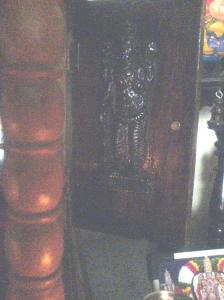 There is a double door to this room. The one at adiyen’s place represents Jayan-Vijayan, the Dwara Palakas (temple guards of the entrance) who are usually found in any Sri Vaishnava temple. It is said that one should enter a temple only after asking the permission of Jayan-Vijayan!
There is a double door to this room. The one at adiyen’s place represents Jayan-Vijayan, the Dwara Palakas (temple guards of the entrance) who are usually found in any Sri Vaishnava temple. It is said that one should enter a temple only after asking the permission of Jayan-Vijayan!
At home, the doors of the Kovil Azhwar have to be opened early in the morning, after a ritual – clapping the hands and waking the lord before the doors are opened up for Him to give us a glance of His beauty. The various idols have to be adorned with flowers and other rituals performed. The lamps should also be lit.
Speaking of lamps, modern Kovil Azhwars have an electrical bulb fitted into the sanctum sanctorum for better view. This would be useful in places where the Pooja/Perumal rooms are not well lit. Adiyen has retained my grandfather’s Kovil Azhwar without adding any bulb, to retain the natural look. The reason why Archakas at temple light the camphor for the lord is because there was no electricity before, and this was the only way one could see the lord! In a lot of temples in Kerala, they have still chosen to give us a glimpse of the lord only through natural light.
Above the room is the gopuram (temple top with sulptures). Most of the Kovil Azhwars also have the Sri Vaishnava insignia represented on top, in front of the gopuram.
The Kovil Azhwar’s doors, just as is done at the temple, should be closed periodically to give the lord a rest. The doors at home are usually closed in the afternoon (after the food has been offered to Him), and in the night when the lord rests for the day. The doors are opened during the evenings when the lamps are lit again.
To the extent adiyen understands, the Kovil Azhwar at home is representative of a real temple. Few procedures are followed at home in order to inculcate the sense of holiness and depth of bhakti one experiences in a Divya Kshetra. But the Kovil Azhwar is not to be treated as less important than an actual abode of the lord, as the deity inside is as real as the one in the temple. And as the one in Sri Vaikuntam!
Adiyen’s apologies for any factual errors.
Srimathe Ramanujasya Charanau Sharanam Prapadye l
Srimathe Narayanaya Namah ll

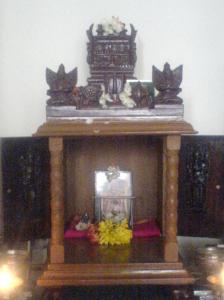
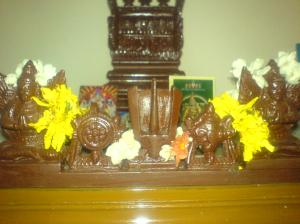
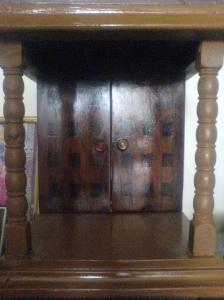
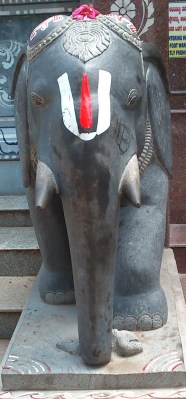
Revered sir
I am delighted to go thro your comments, the facts.
The entire description that you have put forth and the way you did it,
is quite appealing and factual. I had the blessing of Sriman Narayana
to have prayers at the 106 Vaishava divyadesam and have tried to
put my visits like this but in vain. Though short, you have done this
quite nicely and GOD BLESS YOU though I may be younger than you.
Yours in Vaishnavism,
T.S. RAGHAVAN
9840016339
Respected Swami,
Thank you for your kind and supportive comments. I had only put forward my thoughts based on limited knowledge. But the Kovil Azhwar does deserve a special mention for the service it is doing to the lord.
Sir, irrespective of age if you have got the darshan of 106 Divya Desams, definitely you have received Perumal and Thaayar’s kataksham in order to bless all of us! I am still a learner and I am glad to receive your blessings. Thank you so much.
Adiyen.
Thank you for a very informative naration. I am looking to have a Koil Alwar for my new gruham at Chennai & can any one help with address of supplier / manufacturer who can make it the same way as is illustrated with some modifications to suit our gruham.
Dasan
Venkatesan
yesvee1962@yahoo.co.in
Dear Mr. Venkatesan. This is regarding Koil Alwar. Hope you could make to your home. We would also like to have one. Urgently, could you please provide me the details, from where you could get the same.
We appreciate
Dasan
Raghavan
raghavankrish2001@gmail.com
mobile -+91 9884 757 940
Chennai
I did not buy this, this is my grandfather’s who is no more.
You can try looking for a woodwork shop in Triplicane temple side. Ask around and you will surely find information there.